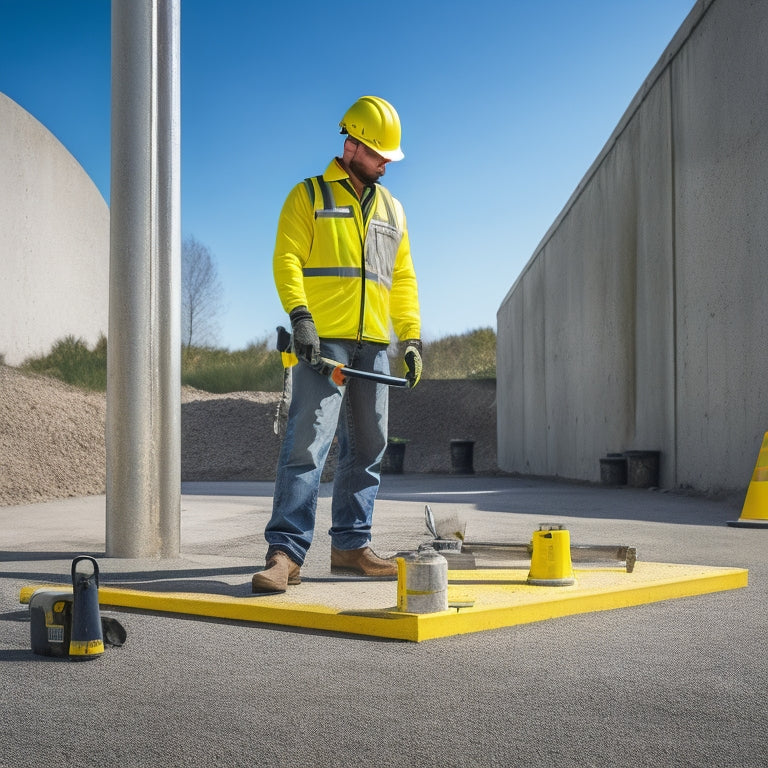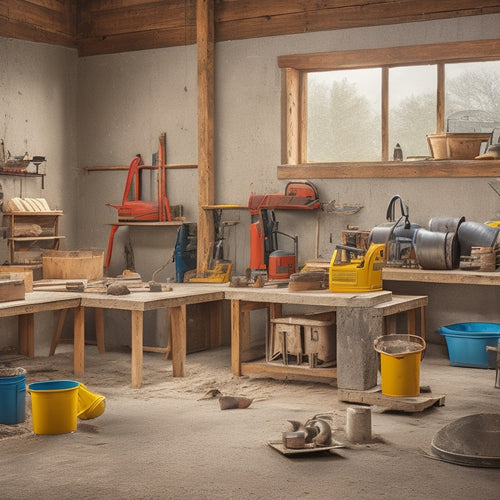
7 Crucial Tips for Choosing Concrete Leveling Tools
Share
When choosing concrete leveling tools, you'll want to define your leveling needs by identifying the type and extent of settlement, considering area size and concrete type, and determining the desired finish. Assess the wall and structural condition to identify cracks, damage, and weaknesses. Select materials that suit your concrete type and guarantee tool compatibility. Prioritize tool precision, evaluating measurement devices for accuracy and consistency. Consider tool durability and maintenance needs, as well as the cost-benefit ratio and user feedback. By following these essential tips, you'll be well on your way to making an informed decision - and a thorough understanding of your project's requirements will soon come into sharp focus.
Key Takeaways
• Assess the concrete type, area size, and desired finish to select the appropriate tools and materials for the leveling task.
• Evaluate the wall and structural condition to identify cracks, damage, and weaknesses that need to be addressed during the leveling process.
• Choose materials that are compatible with the tools and suitable for the concrete type, ensuring effective lifting and stabilization.
• Prioritize precision in measuring devices and tools to achieve accurate concrete leveling results and prevent surface deviations.
• Consider the durability, maintenance requirements, and cost-benefit analysis of the tools to ensure long-term efficiency gains and justified investment.
Define Your Leveling Needs
Before selecting concrete leveling tools, determine the specific requirements of your project by identifying the type and extent of settlement or unevenness, as well as the desired outcome. This will help you choose the most suitable leveling techniques and tools for your specific needs.
Consider the size of the area that needs leveling, the depth of the settlement, and the type of concrete involved. You'll also want to think about the desired finish, whether it's a smooth, even surface or a textured one.
Once you have a clear understanding of your project's requirements, you can start selecting the right tools for the job. This may include hydraulic pumps, injection ports, and grout mixes.
Don't forget to factor in tool maintenance, as regular cleaning and upkeep will guarantee your tools remain in good working order and extend their lifespan.
Assess the Wall Condition
When evaluating the wall condition, you'll need to carefully examine the surface for cracks and damage.
You'll want to identify any structural weaknesses, such as cracks that are wider than a hairline or have shifted over time.
Crack and Damage Assessment
You must conduct a thorough crack and damage assessment to identify the extent of wall deterioration, pinpointing areas that require repair or replacement. This vital step helps you understand the severity of the issue and determines the best course of action.
During the assessment, carefully examine the wall's surface, paying attention to crack patterns and damage indicators. Look for signs of horizontal, vertical, or diagonal cracks, as well as spalling, flaking, or crumbling concrete. Take note of the crack widths, lengths, and depths, as well as any water seepage or staining.
Document your findings, taking photos and making sketches to reference later. This documentation will help you identify patterns and connections between cracks, allowing you to prioritize repairs and develop an effective concrete leveling plan.
Remember to assess the entire wall, not just the most obvious areas of damage. A thorough crack and damage assessment sets the stage for a successful concrete leveling project, ensuring you address all necessary repairs and prevent future issues.
Identify Structural Weaknesses
As you evaluate the wall condition, you need to identify structural weaknesses that can affect the concrete leveling process.
How do the wall's load-bearing components, such as rebar and anchor systems, appear to be performing with respect to supporting the structure? Are they showing signs of corrosion, damage, or deterioration? Take note of any cracks, spalling, or other defects that could impact the wall's ability to distribute loads evenly.
It's crucial to analyze the wall's condition to determine the best approach for concrete leveling.
During foundation inspections, pay attention to the load distribution patterns. Are there any signs of uneven settlement or shifting that could be putting additional stress on certain areas of the wall?
Identify any potential weaknesses in the wall's structural integrity, such as inadequate reinforcement or poor construction practices. By evaluating the wall's condition and identifying structural weaknesses, you can develop a more effective plan for concrete leveling that addresses these issues and guarantees a stable and durable outcome.
Choose the Right Material
Concrete leveling projects require selecting a suitable material that can effectively lift and stabilize the sunken concrete. Polyurethane foam, cement grout, and self-leveling compounds are popular options to assess.
When choosing a material, you'll need to take into account the type of concrete you're working with. Different concrete types, such as residential, commercial, or industrial, may require specific materials that cater to their unique needs. For instance, polyurethane foam is ideal for residential projects, while cement grout may be more suitable for commercial or industrial applications.
It's also vital to guarantee the material is compatible with your tools. You'll want to select a material that can be easily pumped or poured through your equipment and that won't clog or damage your tools. Tool compatibility is significant to guarantee a smooth and efficient leveling process.
Consider the Tool's Precision
When selecting a concrete leveling tool, you'll want to prioritize precision to guarantee accurate results.
The level of accuracy matters, as even slight deviations can compromise the entire project.
You should look for a tool with a high-quality measuring device that provides consistent readings, assuring reliable results.
Level of Accuracy Matters
You need a concrete leveling tool that can deliver precise measurements, guaranteeing your floors or surfaces are even and accurately aligned. The level of accuracy matters because it directly impacts the quality of your work.
When choosing a tool, consider the accuracy techniques employed. Look for tools that utilize advanced measurement methods, such as laser technology or precision sensors, to provide accurate readings.
A high level of accuracy guarantees that you can identify even the slightest deviations in the surface, allowing you to make precise adjustments. This is particularly important in applications where unevenness can have significant consequences, such as in construction or industrial settings.
Measuring Device Quality
The precision of a measuring device is a critical factor in achieving accurate concrete leveling results, as it directly influences the reliability of the readings obtained.
When choosing a concrete leveling tool, you should prioritize devices with high-quality measuring capabilities. This includes considering the type of measuring techniques employed, such as laser, optical, or mechanical systems. Each technique has its strengths and weaknesses, and understanding their differences will help you make an informed decision.
Moreover, you should also look into the device's calibration process. A well-calibrated device guarantees that the readings obtained are accurate and reliable. Check if the device has undergone rigorous testing and calibration procedures to guarantee its precision.
Additionally, consider the device's sensitivity and resolution, as these factors can greatly impact the accuracy of your measurements. By selecting a measuring device with high precision and accuracy, you can confidently rely on the readings obtained, guaranteeing that your concrete leveling projects meet the required standards.
Consistent Readings Guaranteed
To guarantee consistent readings, a concrete leveling tool's precision is paramount, as it directly impacts the reliability of your measurements and ultimately, the success of your project. When evaluating tools, consider their precision regarding accuracy, repeatability, and resolution. A tool with high precision will provide consistent readings, even in varying environmental conditions.
| Technique | Precision Level | User Experience |
|---|---|---|
| Laser Leveling | High | Smooth, accurate measurements with minimal errors |
| Spirit Leveling | Medium | Good for rough estimates, but may require averaging |
| String and Stake | Low | Time-consuming, prone to human error |
When comparing techniques, you'll notice that laser leveling offers the highest precision, followed by spirit leveling, and then string and stake methods. This is because laser leveling uses advanced technology to detect even slight deviations, guaranteeing accurate readings. On the other hand, spirit leveling relies on manual adjustments, which can lead to minor errors. String and stake methods, being the most basic, are prone to human error and require more time and effort. By choosing a tool with high precision, you can guarantee consistent readings and a better user experience.
Check the Tool's Durability
When selecting a concrete leveling tool, you need to guarantee it can withstand the rigors of the job. Frequently, concrete leveling tools are subjected to harsh environments and heavy usage, so it's essential that yours can withstand these demands. A durable tool will save you time and money in the long run by reducing the need for frequent repairs or replacements.
To assess a tool's durability, consider its material compatibility and construction. Look for tools made from high-quality, corrosion-resistant materials that can withstand exposure to harsh chemicals and extreme temperatures. Additionally, consider the tool's design and build quality. A well-built tool with a sturdy frame and robust components will be better equipped to handle heavy usage.
Proper tool maintenance is also vital to extending the lifespan of your concrete leveling tool. Regular cleaning and lubrication can help prevent wear and tear, while proper storage can protect the tool from damage when not in use.
Evaluate the Cost-Benefit Ratio
Evaluating the cost-benefit ratio of a concrete leveling tool helps you determine whether its performance justifies the investment, considering factors like its price, features, and expected lifespan. This analysis is significant in ensuring you get the best value for your money.
When conducting a cost analysis, consider the following key aspects:
-
Will the tool's performance and quality of results justify the initial investment?
-
How long will the tool last, and what maintenance costs can you expect?
-
Are there any additional features or accessories that add value to the tool?
-
Can the tool be used for various applications, increasing its overall investment value?
-
Are there any potential long-term savings, such as reduced labor costs or improved efficiency?
Read User Reviews and Ratings
Having assessed the cost-benefit ratio, you can further validate your decision by examining the experiences of other users who've hands-on knowledge of the concrete leveling tool's performance.
Reading user reviews and ratings can provide valuable insights into the tool's strengths and weaknesses, helping you make a more informed decision.
Look for reviews from multiple sources, including online marketplaces, forums, and specialized websites, to get a thorough understanding of the tool's performance.
Pay attention to the overall rating, as well as the comments and feedback provided by users. This will help you identify common issues, if any, and gauge the tool's reliability and durability.
Additionally, comparing ratings and reviews of different products can facilitate product comparisons, enabling you to choose the best concrete leveling tool for your specific needs.
Frequently Asked Questions
Can I Use Concrete Leveling Tools on Uneven Outdoor Surfaces?
When working on uneven outdoor surfaces, you'll need to adapt your leveling techniques accordingly.
While concrete leveling tools can be used, you'll need to verify the surface is stable and compacted.
You'll also want to take into account the type of tool, as some are better suited for outdoor use than others.
Additionally, you may need to prepare the surface by cleaning and degreasing it before applying the leveling compound.
Are Concrete Leveling Tools Suitable for DIY Projects or Professionals Only?
When considering concrete leveling tools, you're likely wondering if they're suitable for DIY projects or professionals only. The good news is that you can use these tools for both applications.
If you're a DIY enthusiast, you'll find user-friendly tools designed for smaller-scale projects. For professional applications, you'll need more advanced, heavy-duty equipment.
Either way, it's crucial to choose the right tool for your specific project needs to guarantee accuracy and efficiency.
How Often Should I Maintain and Clean Concrete Leveling Tools?
As you wield your concrete leveling tools, imagine a well-oiled machine humming in harmony - that's what regular maintenance can achieve.
You should clean your tools after every use, storing them in a dry place to prevent rust.
For more thorough maintenance, set aside time every 3-6 months to inspect and lubricate moving parts.
This frequency guarantees your tools remain accurate and efficient, saving you time and effort in the long run.
Can I Rent Concrete Leveling Tools Instead of Buying Them?
When deciding between renting or buying concrete leveling tools, you'll want to do a cost comparison.
Calculate the total cost of renting versus buying, considering the frequency and duration of your projects.
Check the rental availability of tools in your area, as limited options might impact your decision.
Weigh the costs against the benefits of owning tools tailored to your specific needs and the convenience of having them readily available.
Are Concrete Leveling Tools Covered by a Manufacturer's Warranty?
Savvy shoppers scrutinize warranties before sealing the deal.
You're wise to wonder if concrete leveling tools are covered by a manufacturer's warranty. The answer is, it depends on the manufacturer.
Reputable brands typically offer a warranty, ensuring tool longevity and protecting your investment.
Look for warranties that cover parts and labor for a reasonable period, say 1-5 years. This safeguard guarantees you're not left with a defective tool and a hefty repair bill.
Conclusion
With the right concrete leveling tools, you're like a conductor leading an orchestra - every movement is precise, every note is in harmony.
By following these 7 essential tips, you'll be well on your way to a smooth, even surface.
Remember, a good tool is an investment, not an expense.
Weigh your options carefully, and you'll be leveling like a pro in no time.
Related Posts
-

What Tools to Rent for a Concrete Home Reno
When tackling a concrete home renovation, you'll need to rent a variety of specialized tools to get the job done. For...
-

Must-Have Handheld Tools for Concrete Repair
When tackling a concrete repair project, it is crucial to have the right handheld tools to achieve a professional fin...
-

Top Mixing Tools for DIY Concrete Block Laying
When it comes to DIY concrete block laying, the right mixing tools are vital for a strong and durable structure. You'...


